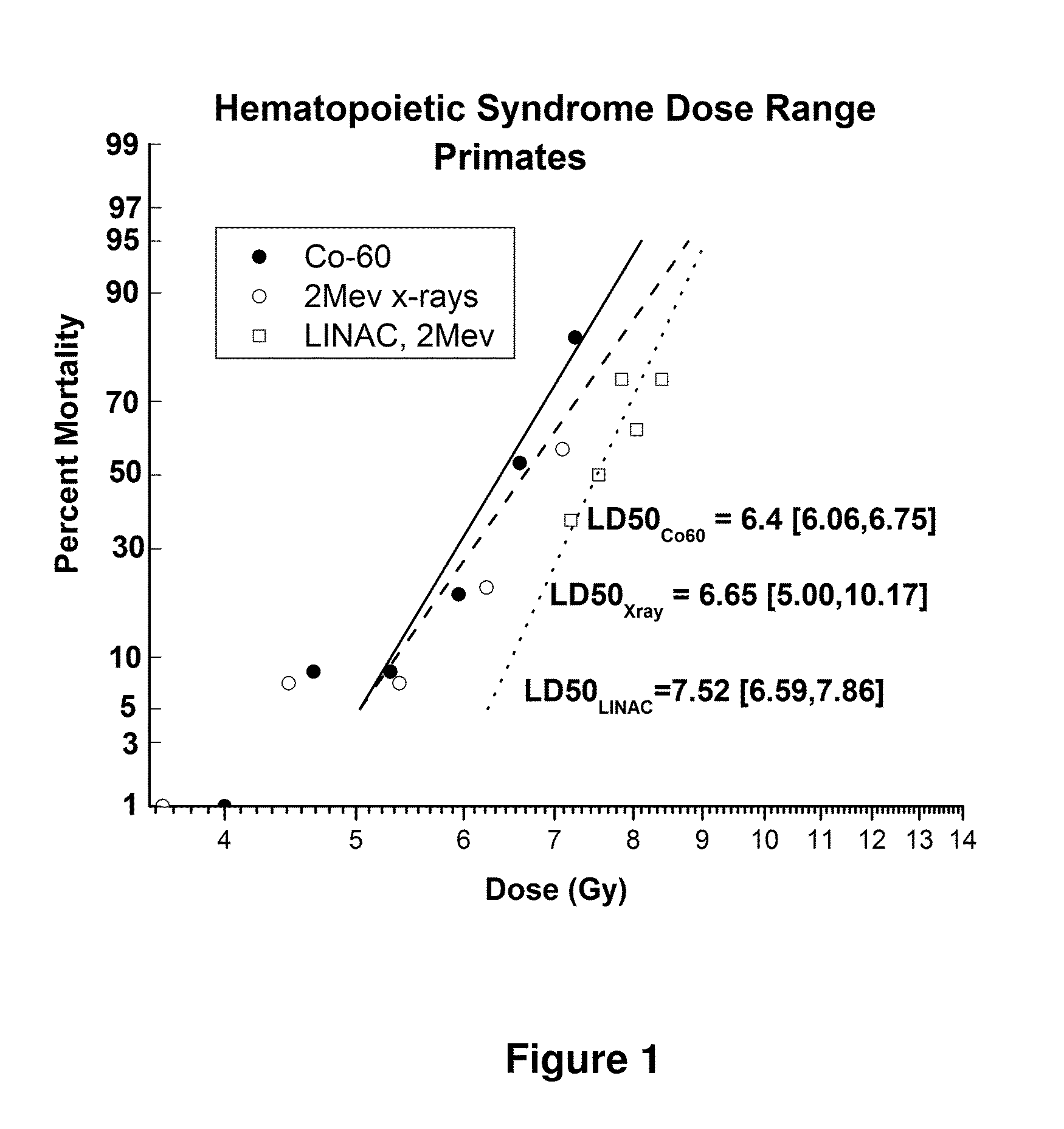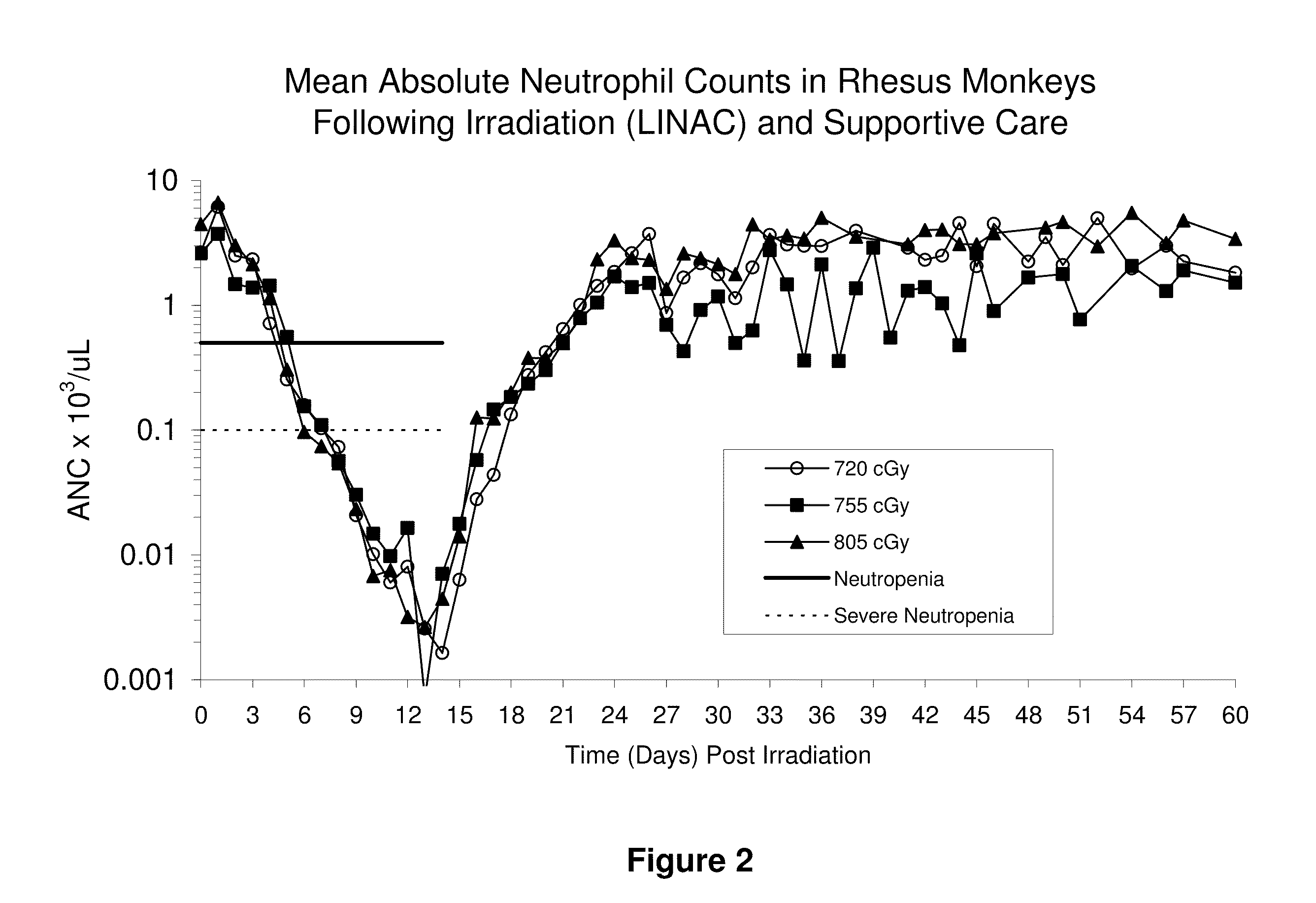Method for the treatment of radiation-induced neutropenia by administration of a multi-pegylated granulocyte colony stimulating factor (g-csf) variant
- Summary
- Abstract
- Description
- Claims
- Application Information
AI Technical Summary
Benefits of technology
Problems solved by technology
Method used
Image
Examples
example 1
Lethal Radiation Dose Response and the Effect of Supportive Care in a Non-Human Primate Model of Radiation-Induced Neutropenia
[0113]The following describes a pilot study designed to define the dose response in rhesus macaques exposed to increasing doses of total body ionizing radiation (TBI) and receiving supportive care (also termed “medical management”). This study was designed to assess:
[0114]1. The LD50 / 30 and supporting radiation-dose survival curves for rhesus macaques exposed to lethal doses of TBI with LINAC-derived 6 MV (average energy, 2 MV) photons plus medical management, and
[0115]2. The effect of medical management on the respective LD50 / 30 and dose response relationship for TBI alone compared to historical data sets.
Materials and Methods
[0116]Forty eight (48) male rhesus monkeys were exposed to bilateral, uniform, total body irradiation (TBI) using a 6 megavolt (MV) LINAC photon source (Varian model #EX-21) (average 2 MV photons) at a dose rate of 80±2.5 cGy / min. Anima...
example 2
Pharmacodynamics and Pharmacokinetics of a Multi-PEGylated G-CSF Variant in a Non-Human Primate Model of Radiation-Induced Neutropenia
Study Protocol:
[0128]The studies were conducted according to the principles enunciated in the Guide for the Care and Use of Laboratory Animals (The Institute of Laboratory Animal Resources, National Research Council, 1996). Male rhesus monkeys (Macaca mulatta) with a mean weight of 4.6+ / −0.7 kg were exposed to 250 kVp X-irradiation at 0.13 Gy / min unilaterally in the posterior-anterior position, and rotated 108E at mid-dose (3.00 Gy) to the anterior-posterior position for the completion of the total 6.00 Gy exposure. Animals received clinical support, consisting of antibiotics, fresh irradiated whole blood, and fluids, as needed. Gentamicin (Elkin Sinn, Cherry Hill N.J.) was administered intramuscularly (i.m.) every day (q.d.) at 10 mg / day for the first seven days of treatment. Baytril® (Bayer Corp., Shawnee Mission, Kans.) was administered 10 mg / day i...
example 3
Radiomitigating Activity of a Subcutaneously Administered Multi-PEGylated G-CSF Variant after Lethal Radiation Exposure in C57BL / 6 Mice
[0138]The efficacy of an exemplary multi-PEGylated G-CSF variant (identified herein as Maxy-G34) was tested at a 1 mg / kg dosage and at two different lethal doses of radiation. Mice at each radiation dose level were apportioned into treatment groups of 20 mice each (10 females and 10 males) receiving Maxy-G34 on days 1, 7, and 14 or days 1 and 7 following irradiation at 7.76 Gy or at 7.96 Gy. Vehicle-treated mice received diluent (a sterile liquid solution of 10 mM sodium acetate, 45 mg / ml mannitol, 0.05 mg / ml polysorbate 20, pH 4.0) on days 1, 7, and 14. Thus, the three groups of mice received one of the following treatments:[0139]1. Maxy-G34; 24±4 hr and 7 d±4 hr after 7.76 Gy irradiation (Maxy-G34 d1, d7)[0140]2. Maxy-G34; 24±4 hr, 7 d±4 hr and 14 d±4 hr after 7.76 Gy irradiation (Maxy-G34 d1, d7, d14)[0141]3. Vehicle; 24±4 hr, 7 d±4 hr and 14 d±4 ...
PUM
| Property | Measurement | Unit |
|---|---|---|
| Time | aaaaa | aaaaa |
| Time | aaaaa | aaaaa |
| Dimensionless property | aaaaa | aaaaa |
Abstract
Description
Claims
Application Information
 Login to View More
Login to View More - Generate Ideas
- Intellectual Property
- Life Sciences
- Materials
- Tech Scout
- Unparalleled Data Quality
- Higher Quality Content
- 60% Fewer Hallucinations
Browse by: Latest US Patents, China's latest patents, Technical Efficacy Thesaurus, Application Domain, Technology Topic, Popular Technical Reports.
© 2025 PatSnap. All rights reserved.Legal|Privacy policy|Modern Slavery Act Transparency Statement|Sitemap|About US| Contact US: help@patsnap.com



